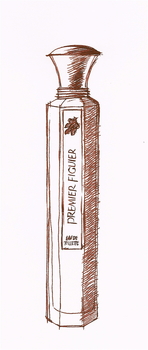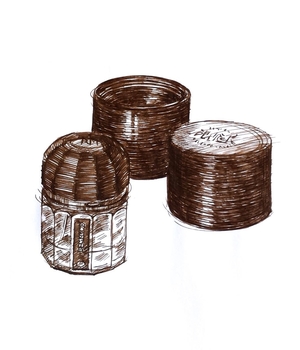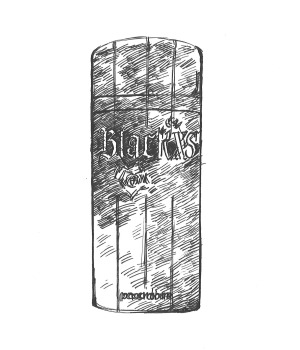Tagged With ‘Puig’
L’Artisan Parfumeur
Premier Figuier
20 October, 2017
 L’Artisan Parfumeur began life in as a small independent brand back in 1979, when Jean Laporte opened his first boutique on Paris’s Rue de Grenelle. Laporte (who had already founded Sisley Paris in 1972) trained as a chemist but had a keen nose, and his first commercial fragrance, Mure et Musc, really captured the spirit of its time. A sweet, slightly hippyish scent, combining blackberries and musk, it established his name and became a big seller in the newly emerging niche-perfume market.
L’Artisan Parfumeur began life in as a small independent brand back in 1979, when Jean Laporte opened his first boutique on Paris’s Rue de Grenelle. Laporte (who had already founded Sisley Paris in 1972) trained as a chemist but had a keen nose, and his first commercial fragrance, Mure et Musc, really captured the spirit of its time. A sweet, slightly hippyish scent, combining blackberries and musk, it established his name and became a big seller in the newly emerging niche-perfume market.
Jean Laporte sold up in 1982 and went on to found the smaller but highly regarded Maitre Parfumeur et Gantier, but L’Artisan Parfumeur continued to expand, fuelled by a run of ground-breaking fragrances. After a long, slow drift into the perfume wilderness, the brand was bought by the Spanish giant Puig, which has given it a much-needed makeover, though it can hardly be regarded as a small independent any more.
Premier Figuier, created by Olivia Giacobetti and released in 1994, very much lives up to its name, in that it was the first perfume to really smell of figs (the fruit but more especially the leaves). I love their scent, which is intensely green and slightly earthy and somehow very sexy, which surely has something to do with their association with baking Mediterranean heat.
Premier Figuier captures that scent perfectly, managing to smell both fresh and slightly sultry at the same time; it also lasts for most of the day. For many years it has been among my favourite fragrances, but not long ago someone pointed out that, like some other perfumes, it has the odd property of also smelling weirdly similar to something else – in this case coconut, which is a scent I’ve never much liked.
As a result, now I get the olfactory equivalent of double vision every time I wear it, which (much to my regret) has slightly lessened its appeal. But don’t let that put you off: if you can ignore my spoiler alert it’s well worth trying.
Ramón Monegal
Dry Wood
2 March, 2015
 The world of perfume is full of great stories – some of them true, others completely bogus or quietly tweaked by fiendish marketeers. The story of Ramón Monegal is one of the better ones, and it’s also more interesting than most. The nice thing is that it has a happy ending too.
The world of perfume is full of great stories – some of them true, others completely bogus or quietly tweaked by fiendish marketeers. The story of Ramón Monegal is one of the better ones, and it’s also more interesting than most. The nice thing is that it has a happy ending too.
Monegal’s great-grandfather founded Myrurgia, which during the twentieth century became the best-known perfume brand in Spain. Ramón joined the business in 1972, training at Firmenich in Geneva and in Paris with the famous perfumer Pierre Bourdon (creator of Davidoff’s Cool Water and Serge Lutens’ Feminité du Bois).
Ramón created his first perfume for Myrurgia in 1979, but he also went on to develop scents for other brands, from Adolfo Dominguez to Inès de la Fressange. He eventually became vice-president of the family company, but in 2000 it was sold to Puig, the giant Barcelona-based fragrance-and-fashion group, which owns everything from Jean-Paul Gaultier to Penhaligon’s and L’Artisan Parfumeur.
The transition from owner to employee is surely always a difficult one, and though Monegal was appointed development director for the group’s fragrance brands, it must have hurt when, in 2007, Puig closed Myrurgia down. Monegal left the same year, but in 2010 he launched his own brand, and in 2014 he made a remarkable comeback by releasing fourteen new fragrances in one go. All the ones I’ve smelled so far are interesting and unusual, and Dry Wood is no exception.
It’s been described as a ‘sharp sandalwood’, but it also reminds me of a top-quality men’s aftershave from the 1970s, with hints of cedar and pine as well as sandalwood; if you remember the old ‘things happen after a Badedas bath’ adverts you’ll know the kind of thing I mean. It has great staying-power, and after a while smells woodier than it does to start with, though still with a touch of pine and turpentine.
Like all the perfumes in the range, Dry Wood comes in attractively luxurious packaging, also designed by Monegal. The chunky twelve-sided ‘inkwell’ bottles, with their flip-up black domed caps, are apparently inspired by his love of literature, and are contained in black Bakelite tubes, which screw closed in a very satisfying way. Perhaps it’s not surprising that these perfumes are expensive, at £130 for just 50ml (or $160 in the States).
The only problem at the moment is buying them: currently they’re only available from Harrods in the UK or Nieman Marcus in the US, which means they’re not going to get as wide an exposure as I think they deserve. Still, they’re well worth tracking down if you have the dedication (and the cash).
Paco Rabanne
Black XS for Men
9 July, 2014
 Perfumes can suggest many things. They can be uplifting, outrageous, disgusting, sexy, hard, delicious, warm, cold, luxurious, even sad. It might seem a bit far-fetched to describe a perfume as silly, but that’s what I think of Black XS by Paco Rabanne, and it’s also why I like it.
Perfumes can suggest many things. They can be uplifting, outrageous, disgusting, sexy, hard, delicious, warm, cold, luxurious, even sad. It might seem a bit far-fetched to describe a perfume as silly, but that’s what I think of Black XS by Paco Rabanne, and it’s also why I like it.
Created by Oliver Cresp (co-creator of Thierry Mugler’s love-it or loathe-it Angel) at perfume powerhouse Firmenich and licensed to fragrance multinational Puig, Black XS was launched in 2005. Its black-glass flip-top bottle originally came in an outer slip-case with a shirtless photo of the English model and amateur boxer Will Chalker, which added to its charm.
Packaging aside, its appeal is pretty simple: pump the spray button and you get an unexpectedly fruity blast of ripe strawberries – sweet, girly and completely at odds with the rather Gothic / Twilight-style design and lettering of the bottle. It’s not what you’d call a complex fragrance, but occasionally it’s fun to forget about trying to be cool and sophisticated: perfumes, like people, can sometimes take themselves too seriously, and there’s a silliness about Black XS that makes me smile every time I spray it on.
What’s really funny, though, is that Black XS doesn’t actually have any strawberry in it at all – at least it’s not among the official list of ingredients. What it does have is lemon, calamanzi (a kind of orange native to the Philippines), sage and what most perfume sites describe as ‘tagete’, which I’m assuming is an illiterate corruption of Tagetes, the Latin name for marigold.
The Mexican marigold, Tagetes erecta, is the source of an oil used in perfumery because of its attractive appley scent, and I wonder whether it’s the combination of orange, lemon and apple that fools my nose into thinking that what I’m really smelling is strawberry? If the effect is intentional it’s dead clever, but it’s the kind of thing that professional perfumers do all the time. Personally I think it’s magic.